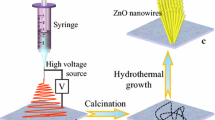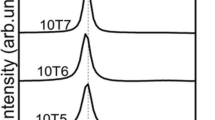Abstract
Copper oxide nanowires and nanoparticles were fabricated through electrospinning followed by calcinations in different heating conditions. It was found that the solution viscosity and environment humidity had great impact on the morphologies of precursor nanowires, and the parameters of heat treatment, including final temperature and heating rate, significantly affected the product morphologies.
Similar content being viewed by others
References
Chen P C, Shen G, Zhou C. Chemical sensors and electronic noses based on 1-D metal oxide nanostructures. IEEE T Nanotechnol, 2008, 7: 668–682
Al-Enizi A M, Elzatahry A A, Abdullah A M, et al. Synthesis and electrochemical properties of nickel oxide/carbon nanofiber composites. Carbon, 2014, 71: 276–283
Li Q, Liu E, Lu Z, et al. HEPES and polyol mediated solvothermal synthesis of hierarchical porous ZnO microspheres and their improved photocatalytic activity. Mater Lett, 2014, 130: 115–119
Teo W E, Inai R, Ramakrishna S. Technological advances in electrospinning of nanofibers. Sci Tech Adv Mater, 2011, 12: 013002
Rieger K A, Schiffman J D. Electrospinning an essential oil: Cinnamaldehyde enhances the antimicrobial efficacy of chitosan/poly (ethylene oxide) nanofibers. Carbohydr Polym, 2014, 113: 561–568
Zheng B, Liu G, Yao A, et al. A sensitive AgNPs/CuO nanofibers non-enzymatic glucose sensor based on electrospinning technology. Sensor Actuat B-Chem, 2014, 195: 431–438
Lu T, Olesik S V. Electrospun polyvinyl alcohol ultra-thin layer chromatography of amino acids. J Chromatogr B, 2013, 912: 98–104
Jae Y P, Sang S K. Growth of nanograins in electrospun ZnO nanofibers. J Am Ceram Soc, 2009, 92: 1691–1694
Liu M, Wang Y, Cheng Z, et al. Function of NaOH hydrolysis in electrospinning ZnO nanofibers via using polylactide as templates. Mat Sci Eng B-Solid, 2014, 187: 89–95
Lin D D, Wu H, Pan W. Photoswitches and memories assembled by electrospinning aluminum-doped zinc oxide single nanowires. Adv Mater, 2007, 19: 3968–3972
Wu W Y, Ting J M, Huang P J. Electrospun ZnO nanowires as gas sensors for ethanol detection. Nanoscale Res Lett, 2009, 4: 513–517
Choi J K, Hwang I S, Kim S J, et al. Design of selective gas sensors using electrospun Pd-doped SnO2 hollow nanofibers. Sensor Actuat B-Chem, 2010, 150: 191–199
Li L, Yin X, Liu S, et al. Electrospun porous SnO2 nanotubes as high capacity anode materials for lithium ion batteries. Electro Chem Commun, 2010, 12: 1383–1386
Zhang Y, Li J, An G, et al. Highly porous SnO2 fibers by electrospinning and oxygen plasma etching and its ethanol-sensing properties. Sensor Actuat B-Chem, 2010, 144: 43–48
Lori E G, Matt L, Benjamin D. ZnO-TiO2 core-shell nanorod/P3HT solar cells. J Am Ceram Soc, 2007, 111: 18451–18456
Xu K, Tian X J, Yu H B, et al. Large-scale assembly of Cu/CuO nanowires for nano-electronic device fabrication. Sci China Tech Sci, 2014, 57: 734–737
Wu H, Zhang R, Liu X, et al. Electrospinning of Fe, Co, and Ni nanofibers: Synthesis, assembly, and magnetic properties. Chem Mater, 2007, 19: 3506–3511
Pankaj G, Casey E, Timothy E. Long. Electrospinning of linear homopolymers of poly (methyl methacrylate): Exploring relationships between fiber formation, viscosity, molecular weight and concentration in a good solvent. Polymer, 2005, 46: 4799–4810
Deitzel J M, Kleinmeyer J, Harris D, et al. The effect of processing variables on the morphology of electrospun nanofibers and textiles. Polymer, 2001, 42: 261–272
Author information
Authors and Affiliations
Corresponding author
Rights and permissions
About this article
Cite this article
Cai, Y., Wang, W., Chen, Z. et al. Formation of copper oxide nanowires and nanoparticles via electrospinning. Sci. China Technol. Sci. 58, 612–616 (2015). https://doi.org/10.1007/s11431-014-5746-3
Received:
Accepted:
Published:
Issue Date:
DOI: https://doi.org/10.1007/s11431-014-5746-3




